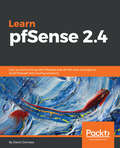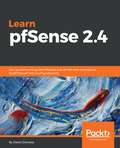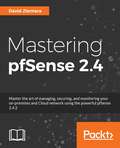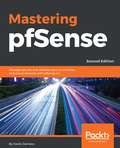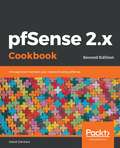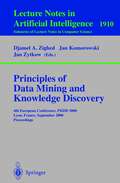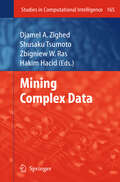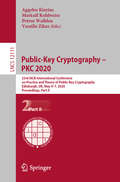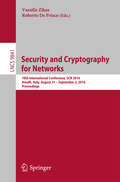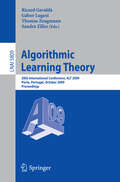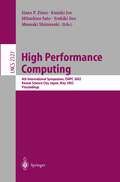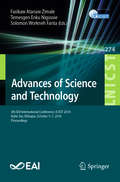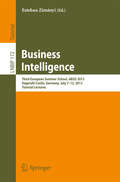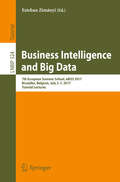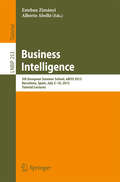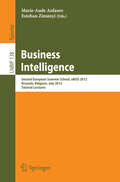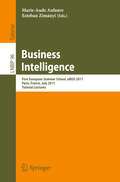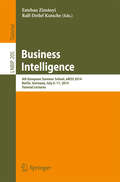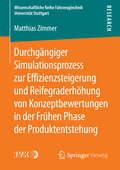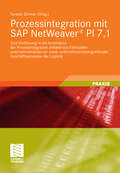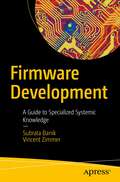- Table View
- List View
Learn pfSense 2.4: Get up and running with Pfsense and all the core concepts to build firewall and routing solutions
by David ZientaraInstall, Configure and Setup different connections with pfSense Key Features Build firewall and routing solutions with PfSense. Learn how to create captive portals, how to connect Pfsense to your https environment and so on. Practical approach towards building firewall solutions for your organization Book Description As computer networks become ubiquitous, it has become increasingly important to both secure and optimize our networks. pfSense, an open-source router/firewall, provides an easy, cost-effective way of achieving this – and this book explains how to install and configure pfSense in such a way that even a networking beginner can successfully deploy and use pfSense. This book begins by covering networking fundamentals, deployment scenarios, and hardware sizing guidelines, as well as how to install pfSense. The book then covers configuration of basic services such as DHCP, DNS, and captive portal and VLAN configuration. Careful consideration is given to the core firewall functionality of pfSense, and how to set up firewall rules and traffic shaping. Finally, the book covers the basics of VPNs, multi-WAN setups, routing and bridging, and how to perform diagnostics and troubleshooting on a network. What you will learn Install pfSense Configure additional interfaces, and enable and configure DHCP Understand Captive portal Understand firewalls and NAT, and traffic shaping Learn in detail about VPNs Understand Multi-WAN Learn about routing and bridging in detail Understand the basics of diagnostics and troubleshooting networks Who this book is for This book is towards any network security professionals who want to get introduced to the world of firewalls and network configurations using Pfsense. No knowledge of PfSense is required
Learn pfSense 2.4: Get up and running with Pfsense and all the core concepts to build firewall and routing solutions
by David ZientaraInstall, Configure and Setup different connections with pfSense Key Features Build firewall and routing solutions with PfSense. Learn how to create captive portals, how to connect Pfsense to your https environment and so on. Practical approach towards building firewall solutions for your organization Book Description As computer networks become ubiquitous, it has become increasingly important to both secure and optimize our networks. pfSense, an open-source router/firewall, provides an easy, cost-effective way of achieving this – and this book explains how to install and configure pfSense in such a way that even a networking beginner can successfully deploy and use pfSense. This book begins by covering networking fundamentals, deployment scenarios, and hardware sizing guidelines, as well as how to install pfSense. The book then covers configuration of basic services such as DHCP, DNS, and captive portal and VLAN configuration. Careful consideration is given to the core firewall functionality of pfSense, and how to set up firewall rules and traffic shaping. Finally, the book covers the basics of VPNs, multi-WAN setups, routing and bridging, and how to perform diagnostics and troubleshooting on a network. What you will learn Install pfSense Configure additional interfaces, and enable and configure DHCP Understand Captive portal Understand firewalls and NAT, and traffic shaping Learn in detail about VPNs Understand Multi-WAN Learn about routing and bridging in detail Understand the basics of diagnostics and troubleshooting networks Who this book is for This book is towards any network security professionals who want to get introduced to the world of firewalls and network configurations using Pfsense. No knowledge of PfSense is required
Learn pfSense 2.4: Get Up And Running With Pfsense And All The Core Concepts To Build Firewall And Routing Solutions
by David ZientaraThis book covers everything the reader needs to know to get pfSense up and running, as well as how to configure core pfSense services to both secure and optimize their networks, third party packages that extend the functionality of pfSense, and the basics of diagnostics and troubleshooting networks.
Mastering pfSense: Manage, secure, and monitor your on-premise and cloud network with pfSense 2.4
by David ZientaraInstall and configure a pfSense router/firewall, and become a pfSense expert in the process.About This BookYou can always do more to secure your software – so extend and customize your pfSense firewallBuild a high availability security system that's fault-tolerant – and capable of blocking potential threatsPut the principles of better security into practice by implementing examples provided in the textWho This Book Is ForThis book is for those with at least an intermediate understanding of networking. Prior knowledge of pfSense would be helpful but is not required.Those who have the resources to set up a pfSense firewall, either in a real or virtual environment, will especially benefit, as they will be able to follow along with the examples in the book.What You Will LearnConfigure pfSense services such as DHCP, Dynamic DNS, captive portal, DNS, NTP and SNMPSet up a managed switch to work with VLANsUse pfSense to allow, block and deny traffic, and to implement Network Address Translation (NAT)Make use of the traffic shaper to lower and raise the priority of certain types of trafficSet up and connect to a VPN tunnel with pfSenseIncorporate redundancy and high availability by utilizing load balancing and the Common Address Redundancy Protocol (CARP)Explore diagnostic tools in pfSense to solve network problemsIn DetailpfSense has the same reliability and stability as even the most popular commercial firewall offerings on the market – but, like the very best open-source software, it doesn't limit you.You're in control – you can exploit and customize pfSense around your security needs.Mastering pfSense - Second Edition, covers features that have long been part of pfSense such as captive portal, VLANs, traffic shaping, VPNs, load balancing, Common Address Redundancy Protocol (CARP), multi-WAN, and routing. It also covers features that have been added with the release of 2.4, such as support for ZFS partitions and OpenVPN 2.4. This book takes into account the fact that, in order to support increased cryptographic loads, pfSense version 2.5 will require a CPU that supports AES-NI.The second edition of this book places more of an emphasis on the practical side of utilizing pfSense than the previous edition, and, as a result, more examples are provided which show in step-by-step fashion how to implement many features.Style and approachPractical guide to learn the advanced functionalities of pfSense with minimum fuss.
Mastering pfSense: Manage, secure, and monitor your on-premise and cloud network with pfSense 2.4
by David ZientaraInstall and configure a pfSense router/firewall, and become a pfSense expert in the process.About This BookYou can always do more to secure your software – so extend and customize your pfSense firewallBuild a high availability security system that's fault-tolerant – and capable of blocking potential threatsPut the principles of better security into practice by implementing examples provided in the textWho This Book Is ForThis book is for those with at least an intermediate understanding of networking. Prior knowledge of pfSense would be helpful but is not required.Those who have the resources to set up a pfSense firewall, either in a real or virtual environment, will especially benefit, as they will be able to follow along with the examples in the book.What You Will LearnConfigure pfSense services such as DHCP, Dynamic DNS, captive portal, DNS, NTP and SNMPSet up a managed switch to work with VLANsUse pfSense to allow, block and deny traffic, and to implement Network Address Translation (NAT)Make use of the traffic shaper to lower and raise the priority of certain types of trafficSet up and connect to a VPN tunnel with pfSenseIncorporate redundancy and high availability by utilizing load balancing and the Common Address Redundancy Protocol (CARP)Explore diagnostic tools in pfSense to solve network problemsIn DetailpfSense has the same reliability and stability as even the most popular commercial firewall offerings on the market – but, like the very best open-source software, it doesn't limit you.You're in control – you can exploit and customize pfSense around your security needs.Mastering pfSense - Second Edition, covers features that have long been part of pfSense such as captive portal, VLANs, traffic shaping, VPNs, load balancing, Common Address Redundancy Protocol (CARP), multi-WAN, and routing. It also covers features that have been added with the release of 2.4, such as support for ZFS partitions and OpenVPN 2.4. This book takes into account the fact that, in order to support increased cryptographic loads, pfSense version 2.5 will require a CPU that supports AES-NI.The second edition of this book places more of an emphasis on the practical side of utilizing pfSense than the previous edition, and, as a result, more examples are provided which show in step-by-step fashion how to implement many features.Style and approachPractical guide to learn the advanced functionalities of pfSense with minimum fuss.
Mastering pfSense, Second Edition: Manage, Secure, And Monitor Your On-premise And Cloud Network With Pfsense 2. 4
by David ZientarapfSense is open source router/firewall software based on FreeBSD. This book shows how to install and customize pfSense in a variety of scenarios, providing many concrete examples.
pfSense 2.x Cookbook, Second Edition: Manage And Maintain Your Network Using Pfsense, 2nd Edition
by David ZientarapfSense is a FreeBSD-based firewall that provides a platform for flexible and powerful routing and firewalling. This book focuses on configuring essential and other commonly used pfSense services; such as traffic shaping, redundancy and high availability, static and dynamic routing, backup and restoration of pfSense, and diagnostic tools.
Principles of Data Mining and Knowledge Discovery: 4th European Conference, PKDD, 2000, Lyon, France, September 13-16, 2000 Proceedings (Lecture Notes in Computer Science #1910)
by Djamel A. Zighed Jan Komorowski Jan ZytkowMining Complex Data (Studies in Computational Intelligence #165)
by Djamel A. Zighed Shusaku Tsumoto Zbigniew W. Ras Hakim HacidThe aim of this book is to gather the most recent works that address issues related to the concept of mining complex data. The whole knowledge discovery process being involved, our goal is to provide researchers dealing with each step of this process by key entries. Actually, managing complex data within the KDD process implies to work on every step, starting from the pre-processing (e.g. structuring and organizing) to the visualization and interpretation (e.g. sorting or filtering) of the results, via the data mining methods themselves (e.g. classification, clustering, frequent patterns extraction, etc.). The papers presented here are selected from the workshop papers held yearly since 2006.
Public-Key Cryptography – PKC 2020: 23rd IACR International Conference on Practice and Theory of Public-Key Cryptography, Edinburgh, UK, May 4–7, 2020, Proceedings, Part II (Lecture Notes in Computer Science #12111)
by Vassilis Zikas Aggelos Kiayias Markulf Kohlweiss Petros WalldenThe two-volume set LNCS 12110 and 12111 constitutes the refereed proceedings of the 23rd IACR International Conference on the Practice and Theory of Public-Key Cryptography, PKC 2020, held in Edinburgh, UK, in May 2020. The 44 full papers presented were carefully reviewed and selected from 180 submissions. They are organized in topical sections such as: functional encryption; identity-based encryption; obfuscation and applications; encryption schemes; secure channels; basic primitives with special properties; proofs and arguments; lattice-based cryptography; isogeny-based cryptography; multiparty protocols; secure computation and related primitives; post-quantum primitives; and privacy-preserving schemes.
Security and Cryptography for Networks: 10th International Conference, SCN 2016, Amalfi, Italy, August 31 – September 2, 2016, Proceedings (Lecture Notes in Computer Science #9841)
by Vassilis Zikas Roberto De PriscoThis book constitutes the proceedings of the 10th International Conference on Security and Cryptography, SCN 2016, held in Amalfi, Italy, in August/September 2016. The 30 papers presented in this volume were carefully reviewed and selected from 67 submissions. They are organized in topical sections on encryption; memory protection; multi-party computation; zero-knowledge proofs; efficient protocols; outsourcing computation; digital signatures; cryptanalysis; two-party computation; secret sharing; and obfuscation.
Irrational Persistence: Seven Secrets That Turned a Bankrupt Startup Into a $231,000,000 Business
by Dave ZilkoA modern-day Detroit success story that fuels the entrepreneurial fire Irrational Persistence tells the story of Garden Fresh Gourmet, and how two entrepreneurs turned a million-dollar debt to a 100-million-dollar annual revenue. Woody Allen famously said that 80 percent of success is just showing up; but any entrepreneur can tell you that it's the other 20 percent that's key. The founders of Garden Fresh took that old saying to heart, building so many strategic advantages into their products and business that their 'sales' team didn't have to do any selling—they simply had to show up. In this book, you'll find out what kind of legwork goes into building a mega-success product, and the strategies, methods, and just plain stubbornness that helped two guys from Detroit build a market leader. Garden Fresh Gourmet is now the number-one fresh salsa in the US, shipping over a million units every week to Costco, Walmart, Whole Foods, and other national chains—and it all began with two middle-aged guys with negative funds and plenty of ideas. This book shares their journey, insight, and passion to help you build a better business and take it to the top. Learn how two entrepreneurs went from major debt to major revenue Discover the key characteristics of a product that sells itself Consider why selling out might not be the ultimate goal Track a journey of 'irrational persistence' from rags to riches Garden Fresh Gourmet is an inspiration beyond the journey—the way you run things at the top matters, too. Irrational Persistence shows you how to make the tough decisions, live with the sacrifices, and prioritize your values as you build your brand and just keep on going.
Irrational Persistence: Seven Secrets That Turned a Bankrupt Startup Into a $231,000,000 Business
by Dave ZilkoA modern-day Detroit success story that fuels the entrepreneurial fire Irrational Persistence tells the story of Garden Fresh Gourmet, and how two entrepreneurs turned a million-dollar debt to a 100-million-dollar annual revenue. Woody Allen famously said that 80 percent of success is just showing up; but any entrepreneur can tell you that it's the other 20 percent that's key. The founders of Garden Fresh took that old saying to heart, building so many strategic advantages into their products and business that their 'sales' team didn't have to do any selling—they simply had to show up. In this book, you'll find out what kind of legwork goes into building a mega-success product, and the strategies, methods, and just plain stubbornness that helped two guys from Detroit build a market leader. Garden Fresh Gourmet is now the number-one fresh salsa in the US, shipping over a million units every week to Costco, Walmart, Whole Foods, and other national chains—and it all began with two middle-aged guys with negative funds and plenty of ideas. This book shares their journey, insight, and passion to help you build a better business and take it to the top. Learn how two entrepreneurs went from major debt to major revenue Discover the key characteristics of a product that sells itself Consider why selling out might not be the ultimate goal Track a journey of 'irrational persistence' from rags to riches Garden Fresh Gourmet is an inspiration beyond the journey—the way you run things at the top matters, too. Irrational Persistence shows you how to make the tough decisions, live with the sacrifices, and prioritize your values as you build your brand and just keep on going.
Algorithmic Learning Theory: 20th International Conference, ALT 2009, Porto, Portugal, October 3-5, 2009, Proceedings (Lecture Notes in Computer Science #5809)
by Sandra Zilles Ricard Gavaldà Gabor Lugosi Thomas ZeugmannThis book constitutes the refereed proceedings of the 20th International Conference on Algorithmic Learning Theory, ALT 2009, held in Porto, Portugal, in October 2009, co-located with the 12th International Conference on Discovery Science, DS 2009. The 26 revised full papers presented together with the abstracts of 5 invited talks were carefully reviewed and selected from 60 submissions. The papers are divided into topical sections of papers on online learning, learning graphs, active learning and query learning, statistical learning, inductive inference, and semisupervised and unsupervised learning. The volume also contains abstracts of the invited talks: Sanjoy Dasgupta, The Two Faces of Active Learning; Hector Geffner, Inference and Learning in Planning; Jiawei Han, Mining Heterogeneous; Information Networks By Exploring the Power of Links, Yishay Mansour, Learning and Domain Adaptation; Fernando C.N. Pereira, Learning on the Web.
High Performance Computing: 4th International Symposium, ISHPC 2002, Kansai Science City, Japan, May 15-17, 2002. Proceedings (Lecture Notes in Computer Science #2327)
by Hans P. Zima Kazuki Joe Mitsuhisa Sato Yoshiki Seo Masaaki ShimasakiI wish to welcome all of you to the International Symposium on High Perf- mance Computing 2002 (ISHPC2002) and to Kansai Science City, which is not farfromtheancientcapitalsofJapan:NaraandKyoto.ISHPC2002isthefourth in the ISHPC series, which consists, to date, of ISHPC ’97 (Fukuoka, November 1997), ISHPC ’99 (Kyoto, May 1999), and ISHPC2000 (Tokyo, October 2000). The success of these symposia indicates the importance of this area and the strong interest of the research community. With all of the recent drastic changes in HPC technology trends, HPC has had and will continue to have a signi?cant impact on computer science and technology. I am pleased to serve as General Chair at a time when HPC plays a crucial role in the era of the IT (Information Technology) revolution. The objective of this symposium is to exchange the latest research results in software, architecture, and applications in HPC in a more informal and friendly atmosphere. I am delighted that the symposium is, like past successful ISHPCs, comprised of excellent invited talks, panels, workshops, as well as high-quality technical papers on various aspects of HPC. We hope that the symposium will provide an excellent opportunity for lively exchange and discussion about - rections in HPC technologies and all the participants will enjoy not only the symposium but also their stay in Kansai Science City.
Advances of Science and Technology: 6th EAI International Conference, ICAST 2018, Bahir Dar, Ethiopia, October 5-7, 2018, Proceedings (Lecture Notes of the Institute for Computer Sciences, Social Informatics and Telecommunications Engineering #274)
by Fasikaw Atanaw Zimale Temesgen Enku Nigussie Solomon Workneh FantaThis book constitutes the refereed post-conference proceedings of the 6th International Conference on Advancement of Science and Technology, ICAST 2018, which took place in Bahir Dar, Ethiopia, in October 2018. The 47 revised full papers were carefully reviewed and selected from 71 submissions. The papers present economic and technologic developments in modern societies in five tracks: agro-processing industries for sustainable development, water resources development for the shared vision in blue Nile basin, IT and computer technology innovation, recent advances in electrical and computer engineering, progresses in product design and system optimization.
Business Intelligence: Third European Summer School, eBISS 2013, Dagstuhl Castle, Germany, July 7-12, 2013, Tutorial Lectures (Lecture Notes in Business Information Processing #172)
by Esteban ZimányiTo large organizations, business intelligence (BI) promises the capability of collecting and analyzing internal and external data to generate knowledge and value, thus providing decision support at the strategic, tactical, and operational levels. BI is now impacted by the “Big Data” phenomena and the evolution of society and users. In particular, BI applications must cope with additional heterogeneous (often Web-based) sources, e.g., from social networks, blogs, competitors’, suppliers’, or distributors’ data, governmental or NGO-based analysis and papers, or from research publications. In addition, they must be able to provide their results also on mobile devices, taking into account location-based or time-based environmental data.The lectures held at the Third European Business Intelligence Summer School (eBISS), which are presented here in an extended and refined format, cover not only established BI and BPM technologies, but extend into innovative aspects that are important in this new environment and for novel applications, e.g., pattern and process mining, business semantics, Linked Open Data, and large-scale data management and analysis.Combining papers by leading researchers in the field, this volume equips the reader with the state-of-the-art background necessary for creating the future of BI. It also provides the reader with an excellent basis and many pointers for further research in this growing field.
Business Intelligence and Big Data: 7th European Summer School, eBISS 2017, Bruxelles, Belgium, July 2–7, 2017, Tutorial Lectures (Lecture Notes in Business Information Processing #324)
by Esteban ZimányiThis book constitutes revised tutorial lectures of the 7th European Business Intelligence and Big Data Summer School, eBISS 2017, held in Bruxelles, Belgium, in July 2017. The tutorials were given by renowned experts and covered advanced aspects of business intelligence and big data. This summer school, presented by leading researchers in the field, represented an opportunity for postgraduate students to equip themselves with the theoretical, practical, and collaboration skills necessary for developing challenging business intelligence applications.
Business Intelligence: 5th European Summer School, eBISS 2015, Barcelona, Spain, July 5-10, 2015, Tutorial Lectures (Lecture Notes in Business Information Processing #253)
by Esteban Zimányi Alberto AbellóThis book constitutes the tutorial lectures of the 5th European Business Intelligence Summer School, eBISS 2015, held in Barcelona, Spain, in July 2015. The tutorials presented here in an extended and refined format were given by renowned experts and cover topics including schema evolution for databases and data warehouses, publishing OLAP cubes on the Semantic Web, design issues in social business intelligence projects, context-aware business intelligence, and key performance indicators in data warehouses.
Business Intelligence: Second European Summer School, eBISS 2012, Brussels, Belgium, July 15-21, 2012, Tutorial Lectures (Lecture Notes in Business Information Processing #138)
by Esteban Zimányi Marie-Aude AufaureTo large organizations, business intelligence (BI) promises the capability of collecting and analyzing internal and external data to generate knowledge and value, thus providing decision support at the strategic, tactical, and operational levels. BI is now impacted by the “Big Data” phenomena and the evolution of society and users. In particular, BI applications must cope with additional heterogeneous (often Web-based) sources, e.g., from social networks, blogs, competitors’, suppliers’, or distributors’ data, governmental or NGO-based analysis and papers, or from research publications. In addition, they must be able to provide their results also on mobile devices, taking into account location-based or time-based environmental data.The lectures held at the Second European Business Intelligence Summer School (eBISS), which are presented here in an extended and refined format, cover not only established BI and BPM technologies, but extend into innovative aspects that are important in this new environment and for novel applications, e.g., machine learning, logic networks, graph mining, business semantics, large-scale data management and analysis, and multicriteria and collaborative decision making.Combining papers by leading researchers in the field, this volume equips the reader with the state-of-the-art background necessary for creating the future of BI. It also provides the reader with an excellent basis and many pointers for further research in this growing field.
Business Intelligence: First European Summer School, eBISS 2011, Paris, France, July 3-8, 2011, Tutorial Lectures (Lecture Notes in Business Information Processing #96)
by Esteban Zimányi Marie-Aude AufaureBusiness Intelligence (BI) promises an organization the capability of collecting and analyzing internal and external data to generate knowledge and value, providing decision support at the strategic, tactical, and operational levels. Business Intelligence is now impacted by the Big Data phenomena and the evolution of society and users, and needs to take into account high-level semantics, reasoning about unstructured and structured data, and to provide a simplified access and better understanding of diverse BI tools accessible trough mobile devices. In particular, BI applications must cope with additional heterogeneous (often Web-based) sources, e.g., from social networks, blogs, competitors’, suppliers’, or distributors’ data, governmental or NGO-based analysis and papers, or from research publications. The lectures held at the First European Business Intelligence Summer School (eBISS), which are presented here in an extended and refined format, cover not only established BI technologies like data warehouses, OLAP query processing, or performance issues, but extend into new aspects that are important in this new environment and for novel applications, e.g., semantic technologies, social network analysis and graphs, services, large-scale management, or collaborative decision making. Combining papers by leading researchers in the field, this volume will equip the reader with the state-of-the-art background necessary for inventing the future of BI. It will also provide the reader with an excellent basis and many pointers for further research in this growing field.
Business Intelligence: 4th European Summer School, eBISS 2014, Berlin, Germany, July 6-11, 2014, Tutorial Lectures (Lecture Notes in Business Information Processing #205)
by Esteban Zimányi Ralf-Detlef KutscheThis book constitutes the tutorial lectures of the 4th European Business Intelligence Summer School, eBISS 2014, held in Berlin, Germany, in July 2014.The tutorials presented here in an extended and refined format were given by renowned experts and cover topics including requirements engineering for decision-support systems, visual analytics of large data sets, linked data and semantic technologies, supervised classification on data streams, and knowledge reuse in large organizations.
Durchgängiger Simulationsprozess zur Effizienzsteigerung und Reifegraderhöhung von Konzeptbewertungen in der Frühen Phase der Produktentstehung (Wissenschaftliche Reihe Fahrzeugtechnik Universität Stuttgart)
by Matthias ZimmerMatthias Zimmer befasst sich mit dem Ziel eines durchgängigen Simulationsprozesses zur Steigerung des Reifegrades von Konzeptbewertungen in der Frühen Phase der Produktentwicklung. Er stellt außerdem praxisnah vor, in welchem Kontext die Methode und der Prozess in der Entwicklung bei einem Automobilhersteller durchgeführt und prototypisch eingesetzt werden. Bereits in den frühen Phasen der Produktentstehung ist es notwendig, der steigenden Variantenvielfalt und wachsenden Komplexität in der Automobilentwicklung mit effektiven Methoden und Prozessen zu begegnen. Eine schnelle und effiziente Bewertung von Fahrzeugkonzeptvarianten unterstützt die Entscheidungsfindung und ermöglicht eine effektivere Nutzung des vorhandenen Zeitfensters für Machbarkeitsuntersuchungen und trägt damit zur Umsetzung des Frontloading bei.
Prozessintegration mit SAP NetWeaver® PI 7.1: Eine Einführung in die Architektur der Prozessintegration anhand von Fallstudien unternehmensinterner sowie unternehmensübergreifender Geschäftsprozesse der Logistik
by Torsten ZimmerDie vollständige elektronische Integration logistischer Prozesse in heterogenen Systemlandschaften wird in Zukunft immer mehr an Bedeutung gewinnen. Ebenso wird derzeit die konkrete Umsetzung eines SOA-Konzepts auf Basis eines EAI-Systems unter Verwendung von Webservices sehr stark diskutiert. Wichtigste Ziele dieser Strategien sind der vollständig medienbruchfreie Austausch von Nachrichten sowie eine flexible und entkoppelte Ausführung unternehmensinterner sowie unternehmensübergreifender Geschäftsprozesse. Dieses Buch stellt nach einer Einführung in die Prozessintegration mittels SAP NetWeaver® PI 7.1 zunächst eine Auswahl von für eine Integration geeigneten logistischen Prozessen vor. Anhand theoretischer und praktischer Fallstudien soll dann eine Umsetzung einer Prozessintegration motiviert und unterstützt werden.
Firmware Development: A Guide to Specialized Systemic Knowledge
by Vincent Zimmer Subrata BanikBuild your own system firmware. This book helps you understand system firmware architecture and minimalistic design, and provides a specialized knowledge of firmware development. The book includes guidance on understanding the system firmware build procedure, integrating pieces of firmware and allowing configuration, updating system firmware, creating a development infrastructure for allowing multi-party collaboration in firmware development, and gaining advanced system firmware debugging knowledge.After reading the book you will be able to assume better control while developing your own firmware and know how to interact with native hardware while debugging. You will understand key principles for future firmware development using newer technology, and be ready for the introduction of modern safe programming languages for firmware development. Detailed system firmware development case studies using a futuristic approach cover:Future scalable system firmware development modelsTypes of firmware development (system firmware, device firmware, manageability firmware)Tools and their usage while creating system firmwareHow to build infrastructure for seamless firmware development using a multi-party development modelDebugging methodologies used during various phases of firmware product developmentSetting up key expectations for future firmware, including thinner firmware footprints and faster execution time, easier configuration, and increased transparent security What You Will LearnUnderstand the system firmware working model of the futureGain knowledge to say goodbye to proprietary firmware for different types of firmware developmentKnow the different types of tools required for creating firmware source code before flashing the final image into the boot device of the embedded systemDevelop skills to understand the failure in firmware or in the system and prepare the debugging environment to root cause the defectsDiscern the platform minimal security requirementOptimize the system firmware boot time based on the target hardware requirementComprehend the product development cycle using open source firmware development Who This Book Is For Embedded firmware and software engineers migrating the product development from closed source firmware to open source firmware for product adaptation needs as well as engineers working for open source firmware development. A secondary audience includes engineers working on various bootloaders such as open source firmware, UEFI, and Slim Bootloader development, as well as undergraduate and graduate students working on developing firmware skill sets.
